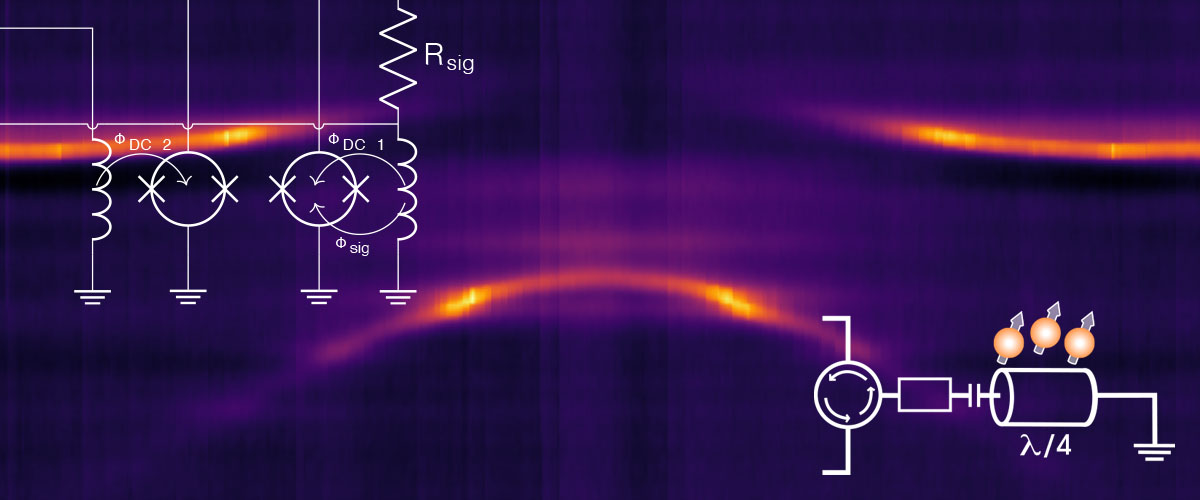Research Program
The research program is dedicated to quantum effects at the nanoscopic scale with a focus on quantum devices and phase coherence in various spin systems. A number of dedicated experimental techniques are used in our laboratory such as: sensitive microwave excitation and detection (continuous and pulsed), fast data acquisition, low temperatures in a dilution refrigerator, vector magnetic field, etc.
Nanofabrication capabilities allows us to build superconducting devices such as on-chip SQUIDs and resonators, on which a mesoscopic sample can be placed and studied. We are in particular interested in diluted spin systems (ions or molecular magnets) in which the spin-spin interactions are naturally reduced. The decrease in unwanted interactions brings an increase in the spin phase coherence. Such systems can show cooperative quantum phenomena and also allows to study the quantum physics of a single spin since its signal is amplified by the number of independent spins in a sample.
A number of research trusts are part of our program and some are listed below.
Hybrid quantum computing; strong-coupling of spins and photons.
Gd3+ spins placed on an on-chip resonator show a very strong spin-photon coupling leading to a cavity resonance splitting as large as 146 MHz. The strong coupling results in an interesting perturbation of the crystal field and can give access to dynamical processes such as active cooling.
Energy diagram of coupled Gd spin-photon system in our resonator
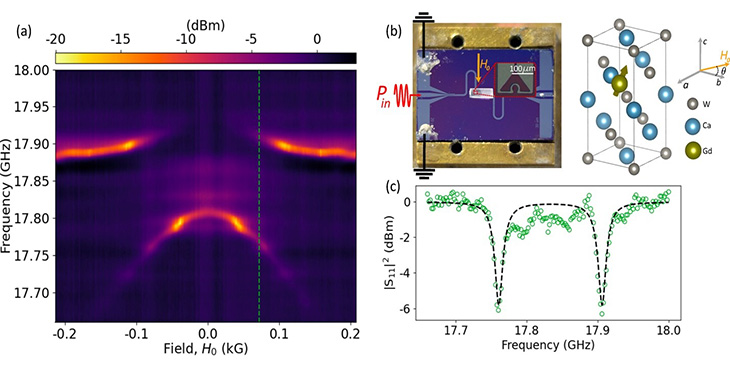
(a) Contour plot showing frequency scans as a function of applied field and (c) a vertical cut at the green dashed line shows the strong coupling resonance split. (b) On-chip superconducting resonator with a CaWO4 crystal on top (left) and the crystal structure showing Gd3+ impurities.
Relevant references:
Franco-Rivera, G.; Cochran, J.R.; Miyashita, S.; Bertaina, S.U.; Chiorescu, I., Strong Coupling of a Gd3+ Multilevel Spin System to an On-Chip Superconducting Resonator, Physical Review Applied, 19, 024067 (2023).
Chiorescu, I.; Groll, N.; Bertaina, S.; Mori, T. and Miyashita, S., Magnetic strong coupling in a spin-photon system and transition to classical regime, Physical Review B, 82 (2), 024413 (2010).
Qubit protection; enhancement of Rabi decay time up to relaxation time
(collaboration with Dr Sylvain Bertaina – Univ of Marseille)
We developed a universal method to engineer dynamical sweet spots where qubits (spins or superconducting qubits) can be operated with reduced interference from the outside world. To this end, we design an image microwave pulse to create a Floquet microwave shield with a motion commensurate to qubit Rabi motion.
See the Experimental protection of quantum coherence by using a phase-tunable image drive in Nature Scientific Reports article and the CNRS press release.
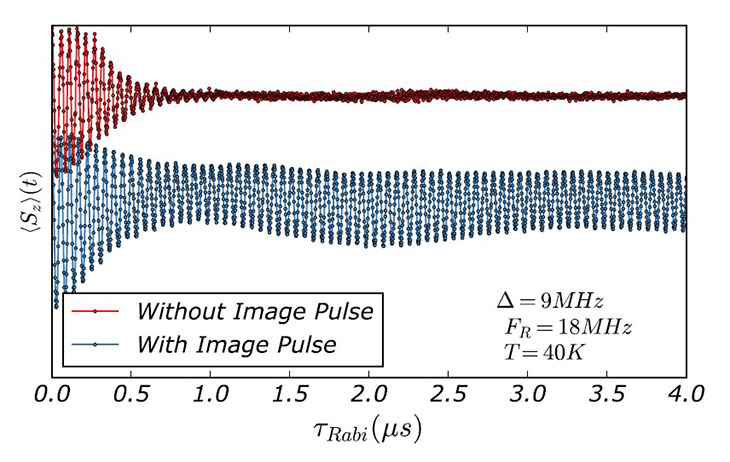
The figure shows Rabi oscillations of Gd3+ spins in a traditional microwave experiment (red, fast decay) and when adding a low power image pulse designed to sustain the nutation (blue, long decay).
A handwaving picture is that of a level repulsion where energy levels are flat and thus the qubit is insensitive in first order to fluctuations of the parameter controlling the horizontal axis. In our universal approach, we build such sweet spots on-demand and they are located in the rotating frame rather than the laboratory frame. Instead of the usual energy levels, we have quasi-energies showing level repulsion vs specific parameters of the rotating frame Hamiltonian.
We also performed an exact numerical study using a system of 28 two-level systems in two situations: (i) a set of identical, resonant qubits with dipolar interactions and (ii) a central qubit interacting with a bath of non-resonant two-level systems (such as nuclear spins or spins of other impurities). In both cases, the simulated microscopic dynamics reveal the build-up of correlations between a qubit and its environment. Basically, the image pulse mentioned above helps the qubit to impose its dynamics and brings the bath in sync motion.
A sketch and an animation representing the main idea of the experiment are shown below.
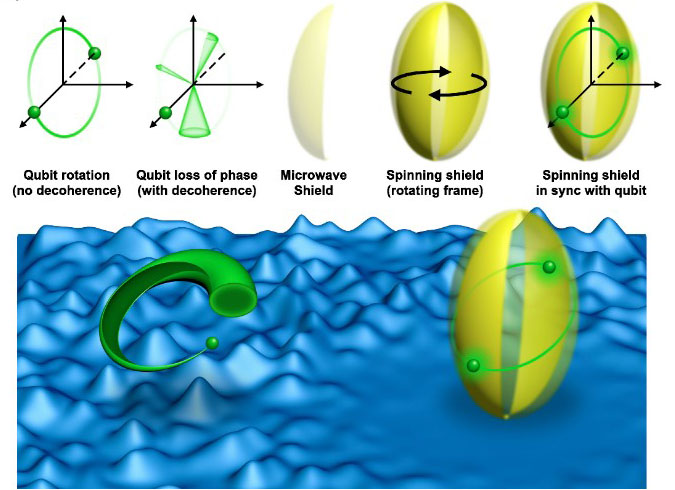
The top figures show the motion of a qubit (green ball) without and with a specially designed Floquet microwave shield (in yellow). The motion of the qubit and shield are commensurate, show by the green ball glowing each time the two meet. Without a shield, the qubit phase information is lost in a disc-like pattern due to decoherence sources (“rough waters” underneath, on left) while with the shield on, the decoherence sources are managed and the coherence is preserved up to qubit’s energy relaxation time.
Relevant references:
Bertaina, S.U.; Vezin, H.; De Raedt, H.; Chiorescu, I., Experimental protection of quantum coherence by using a phase-tunable image drive, Scientific Report, 10 (1), 21643 (2020).
De Raedt, H.; Miyashita, S.; Michielsen, K.; Vezin, H.; Bertaina, S.U.; Chiorescu, I., Sustaining Rabi oscillations by using a phase-tunable image drive, European Physical Journal B, 95 (9), 158 (2022).
In-situ tuning of the resonance frequency of a cavity using the non-linear Meissner effect
We observed the nonlinear Meissner effect (NLME) in Nb films by measuring the resonance frequency of a planar superconducting cavity as a function of the magnitude and the orientation of a parallel magnetic field. Use of low power RF probing in films thinner than the London penetration depth, significantly increases the field for the vortex penetration onset and enables NLME detection under true equilibrium conditions.
A superconducting resonator can thus be tuned in resonance since NLME provides a quadratic field dependence of the resonance frequency.
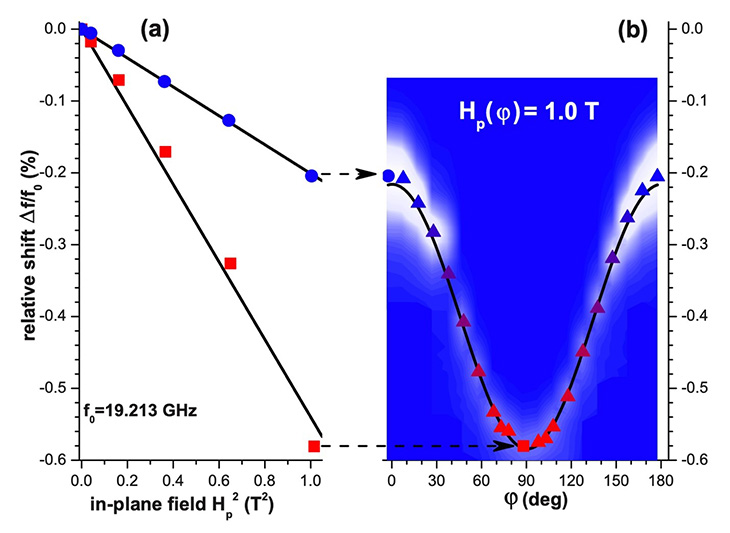
(a) Quadratic field dependence of the resonance frequency of a Nb resonator of rectangular shape when the in-plane field is applied parallel (circles) or perpendicular (squares) to the long axis of the resonator. (b) Geometrical shape anisotropy of NLME when the field is rotated in the resonator plane. The NLME anisotropy allows the study of exotic superconducting materials where the shape anisotropy would be convoluted with the intrinsic anisotropy.
Relevant reference:
Groll, N.; Gurevich, A. and Chiorescu, I., Measurement of the nonlinear Meissner effect in superconducting Nb films using a resonant microwave cavity: A probe of unconventional pairing symmetries, Physical Review B: Rapid Comm/Letters, 81, 020504(R) (2010).
Study of spin-orbit fluctuations as a spin decoherence mechanism
We developed a general framework to address spin decoherence resulting from fluctuations in a spin Hamiltonian and verified the model in the case of the molecular magnet V15. The total molecular spin sees a relatively low amount of g-factor anisotropy; its angular dependence is due to spin-orbit coupling. Our findings demonstrate that the closer the g-factor is to the free electron value ge=2.00232, the smaller the decoherence. The model and the data are in excellent agreement.
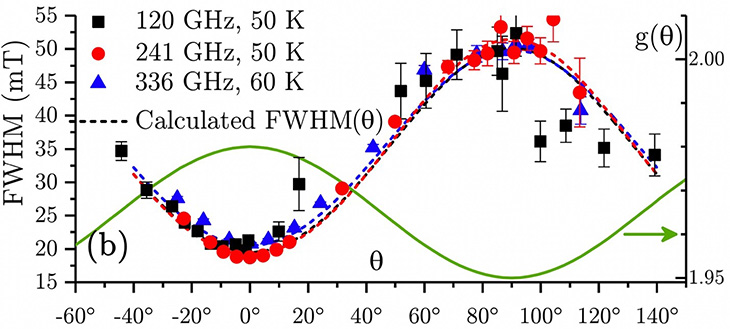
Experimental ESR linewidth obtained using the high-frequency NMFL facilities (dots) as a measure of decoherence, compared to the calculated values using our model. The green curve shows the angular dependency of the g-factor confirming that larger the deviations from ge=2.00232 due to spin-orbit coupling, the larger the decoherence rates.
Relevant reference:
Martens, M.; Franco-Rivera, G.; Dalal, N.S.; Bertaina, S. and Chiorescu, I., Spin-orbit coupling fluctuations as a mechanism of spin decoherence, Physical Review B: Rapid Comm/Letters, 96, 180408(R) (2017).
Sensitive spin detection using DC SQUID
Superconducting Quantum Interference Devices (SQUID) are amongst the most sensitive magnetic flux detectors and are currently used to pick-up magnetic signals from other quantum systems such as superconducting qubits or quantum spins. In our laboratory we design and build superconducting chips containing SQUIDs on which we can place samples containing spins of various nature (ions or molecular magnets). On one hand, the proximity of the SQUID and the spins provides a tremendous increase in sensitivity compared to commercial SQUID equipments where the two are separated. On the other hand, the chip and thus the SQUID will see the same large magnetic field as the studied quantum spins, issue that leads to a significant technological challenge. One part of the answer to this conundrum is to orient the magnetic field perfectly in the plane of the SQUID. We measured perfect SQUID operation under 7 Tesla for Nb thin films.
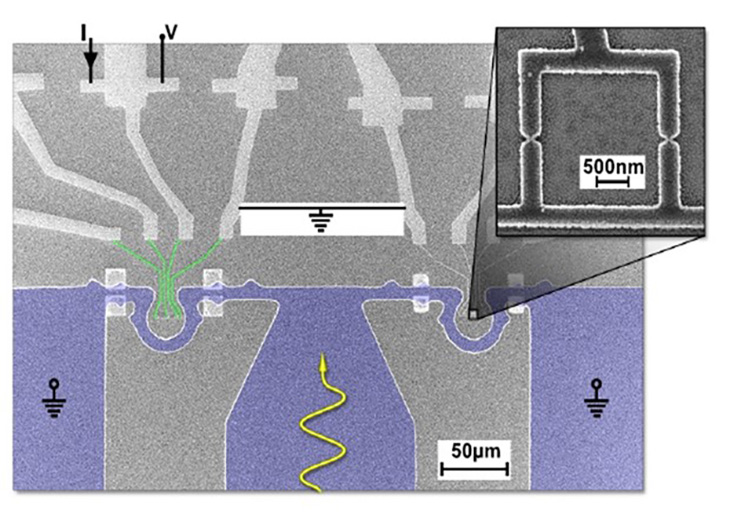
A Nb device implementing a resonator (colorized in purple) coupled to a SQUID placed inside an short-circuit. Device used to detect spin excitation at 14.934 GHz of Gd3+ spins diluted in CaWO4.
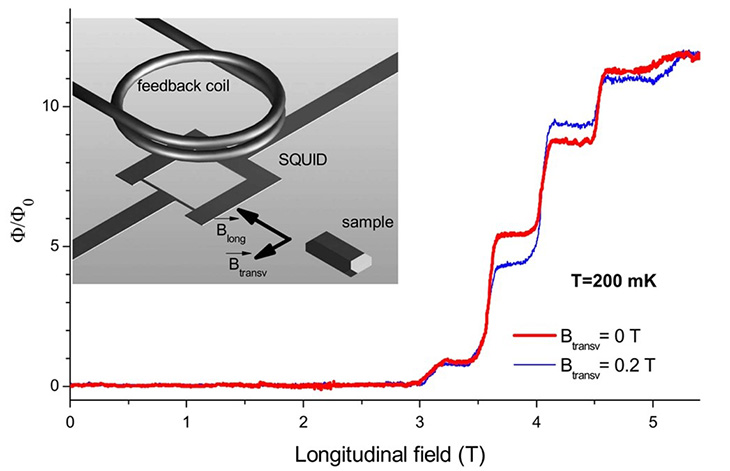
Measured magnetization as a function of a longitudinal field up to 7 Tesla applied along the easy axis of a Mn12-tBuAc single crystal. The geometry is sketched in the insert: a single crystal is placed near an on-chip SQUID and under the feedback coil. The sample is first saturated at -5.5 T, and a real time measurement follows up to +5.5 T, here at a field rate of 1 mT/s. The two curves show the differences in the quantum tunneling jumps - and therefore in the tunneling splitting - for two values of the transverse field, 0 T (thick line) and 0.2 T (thin line) respectively.
Relevant references:
Cochran, J.R.; Franco-Rivera, G.; Zhang, D.; Chen, L.; Wang, Z.; Chiorescu, I., Dual On-Chip SQUID Measurement Protocol for Flux Detection in Large Magnetic Fields, IEEE Transactions on Applied Superconductivity, 31 (6), 1-5 (2021).
Yue, G.; Chen, L.; Barreda, J.; Bevara, V.; Hu, L.; Wu, L.; Wang, Z.; Andrei, P.; Bertaina, S. and Chiorescu, I., Sensitive spin detection using an on-chip SQUID-waveguide resonator, Applied Physics Letters, 111, 202601 (2017).
Chen, L.; Wernsdorfer, W.; Lampropoulos, C.; Christou, G. and Chiorescu, I., On-chip SQUID measurements in the presence of high magnetic fields, Nanotechnology, 21 (40), 405504 (2010).
Harnessing the quantum power of a multi-level system
(collaboration with Dr Sylvain Bertaina – Univ of Marseille)
We have performed several studies on the Mn2+ spins S=5/2 diluted in MgO. The Mn2+ ion has a well-defined spin Hamilonian featuring the possibility to tune in-situ the anharmonicity of its 2S+1 levels. Our collaborative effort successfully demonstrated single and multi-photon Rabi oscillations in low and high RF power regimes, forbidden coherence between two quasi-harmonic systems, and more.
Relevant references:
Bertaina, S.; Yue, G.; Dutoit, C-E. and Chiorescu, I., Forbidden coherent transfer observed between two realizations of quasiharmonic spin systems, Physical Review B, 96, 024428 (2017).
Bertaina, S.; Martens, M.; Egels, M.; Barakel, D. and Chiorescu, I., Resonant single-photon and multiphoton coherent transitions in a detuned regime, Physical Review B, 92, 024408 (2015).
Bertaina, S.; Groll, N.; Chen, L. and Chiorescu, I., Tunable multiphoton Rabi oscillations in an electronic spin system, Physical Review B, 64 (13), 134433 (2011).
Bertaina, S.; Chen, L.; Groll, N.; van Tol, J.; Dalal, N.S. and Chiorescu, I., Multiphoton Coherent Manipulation in Large-Spin Qubits, Physical Review Letters, 102 (5), 050501 (2009).



